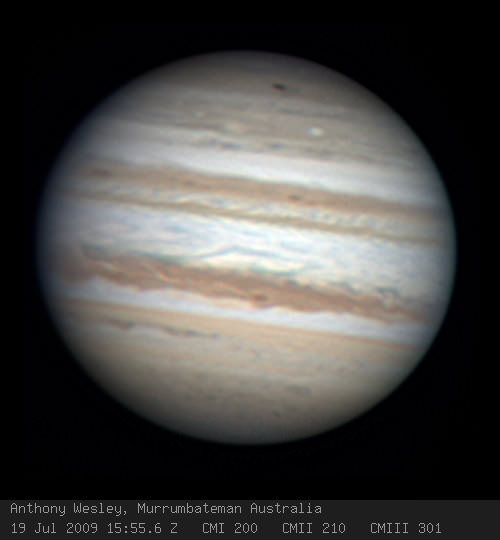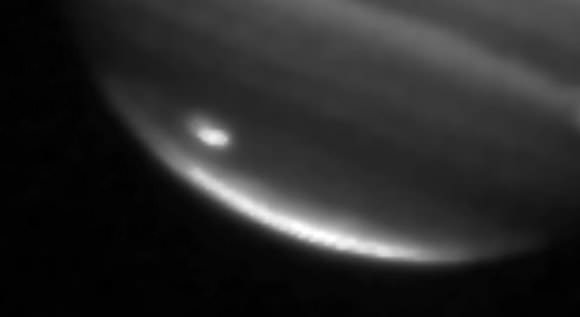[/caption]
As we reported yesterday, an amateur astronomer snapped evidence of an impact on Jupiter. Now, NASA has confirmed the black spot on the giant gas planet is in fact an impact and not just a weather-related disturbance. And Anthony Wesley has now made the biggest observation of his life.
“It still feels very surreal right now,” he told Universe Today. “I guess it will take some time to really sink in (pun intended). I guess it shows that persistence and many hours at the scope eventually pays off.”
The Infrared Telescope Facility at the summit of Mauna Kea, Hawaii, has imaged the south polar region Jupiter, confirming the impact, which occurred on July 19. New infrared images show the likely impact point, with a visibly dark “scar” and bright upwelling particles in the upper atmosphere detected in near-infrared wavelengths, and a warming of the upper troposphere with possible extra emission from ammonia gas detected at mid-infrared wavelengths.
Anthony said imaging Jupiter has been his main passion since 2004. “It’s such a dynamic system that every image I take shows something new and different,” he said, “It keeps me coming back year after year, with bigger and better equipment each time. I never expected to see anything like this of course, but even the routine imaging of Jupiter’s storm systems can reveal a tremendous wealth of detail.”
Anthony said this is one of the areas where amateurs can make a significant contribution to science. “The the study of planetary atmospherics is a very hot topic at the moment and nowhere are the dynamics more evident than on Jupiter,” he said. “Researchers are coming to rely on amateur images of Jupiter for much of their data, augmented by professional images whenever something truly significant occurs that justifies the cost of using the larger instruments.”

“It’s significant that in each of the last 3 years amateurs have made the initial discoveries of new features in the Jovian atmosphere, the colour change of the previously white Oval BA to red in 2007 by Chris Go of the Philippines, the formation of another (smaller) red spot last year by myself, and then this event in 2009. In all cases the amateur work was followed up with imagery from Hubble and other major telescopes.”
This new impact occurred exactly 15 years after the first impacts by the comet Shoemaker-Levy 9, and as the celebrations of the Apollo 11 moon landings are taking place.
Glenn Orton, a scientist at JPL and his team of astronomers kicked into gear early in Monday morning and haven’t stopped tracking the planet. They are downloading data now and are working to get additional observing time on this and other telescopes.
“We were extremely lucky to be seeing Jupiter at exactly the right time, the right hour, the right side of Jupiter to witness the event. We couldn’t have planned it better,” he said.
The top image taken by the Infrared Telescope Facility, was taken at 1.65 microns, a wavelength sensitive to sunlight reflected from high in Jupiter’s atmosphere, and it shows both the bright center of the scar (bottom left) and the debris to its northwest (upper left).
“It could be the impact of a comet, but we don’t know for sure yet,” said Orton. “It’s been a whirlwind of a day, and this on the anniversary of the Shoemaker-Levy 9 and Apollo anniversaries is amazing.”
Shoemaker-Levy 9 was a comet that had been seen to break into many pieces before the pieces hit Jupiter in 1994.
Sources: JPL, email exchange with Anthony Wesley


That impact looks huge.
Has anybody sized it, in say: earth dimensions?
I read that it was approximately the size of Earth on the Sydney Morning Herald news website.
Link::
http://www.smh.com.au/technology/sci-tech/backyard-astronomer-spots-big-bang-on-jupiter-20090721-dria.html
The quote:
“Orton said he was not yet sure whether the object that hit Jupiter was a comet, asteroid or some other piece of space junk. But the impact mark is about the size of the Earth.”
I think it is a little bit smaller than what the SMH said.
More like the size of North America or approximately one half the size of earth.
Granted I’m just eyeballing it and assuming that 10 earths would fit across the equator of Jupiter.
Still massive though.
So, we’ve had two major impacts on Jupiter in 15 years…
What does that do to the probability of a major impact on earth in any given timeframe?
DanNY Says:
July 20th, 2009 at 9:27 pm
“I think it is a little bit smaller than what the SMH said.
More like the size of North America or approximately one half the size of earth.
Granted I’m just eyeballing it and assuming that 10 earths would fit across the equator of Jupiter.”
Agreed, now that I’ve actually thought about it a bit…
Nice to see another example of pro-am collaboration with amateurs making the initial observations. Now would be the time for both to check any wide-field images taken in that region of the sky in the past several weeks or months for any signs for the object pre-impact. While the impact itself may (or may not) have occurred out of sight of Earth, I think it highly improbable that the impactor approached Jupiter completely hidden to Earth for weeks or months. Additional impacts may also be possible over the next few days, as was the case in the SL-9 events, and the planet should be monitored for these too.
Twice in a lifetime! And right in the middle of astronomy’s “Golden Age”. Spectacular. Musta been an asteroid – I’d think a comet would have been spotted before the impact.
Any idea on the size of the impactor? I want to know what it would have done if it hit earth!
Was there any change in Jupiters trajectory,
due to this impact?
Earth and Jupiter trajectory do intercept close enough? We do not won’t it to become a close encounter do we? Is there any work done on this?
Another fine reason to finish building my 12 1/2″ scope!
It’s hard to believe that it’s been 15 years since Shoemaker-Levy 9 impacted. I remember seeing the news reports. It was a spectacular event.
I hope some more data will surface on this new impact. Will all of the amature and professional scopes being used today, it’s possible someone might have cought the object.
I read that the size of the impact mark is approximately the area of the Pacific Ocean.
Outstanding work Anthony!